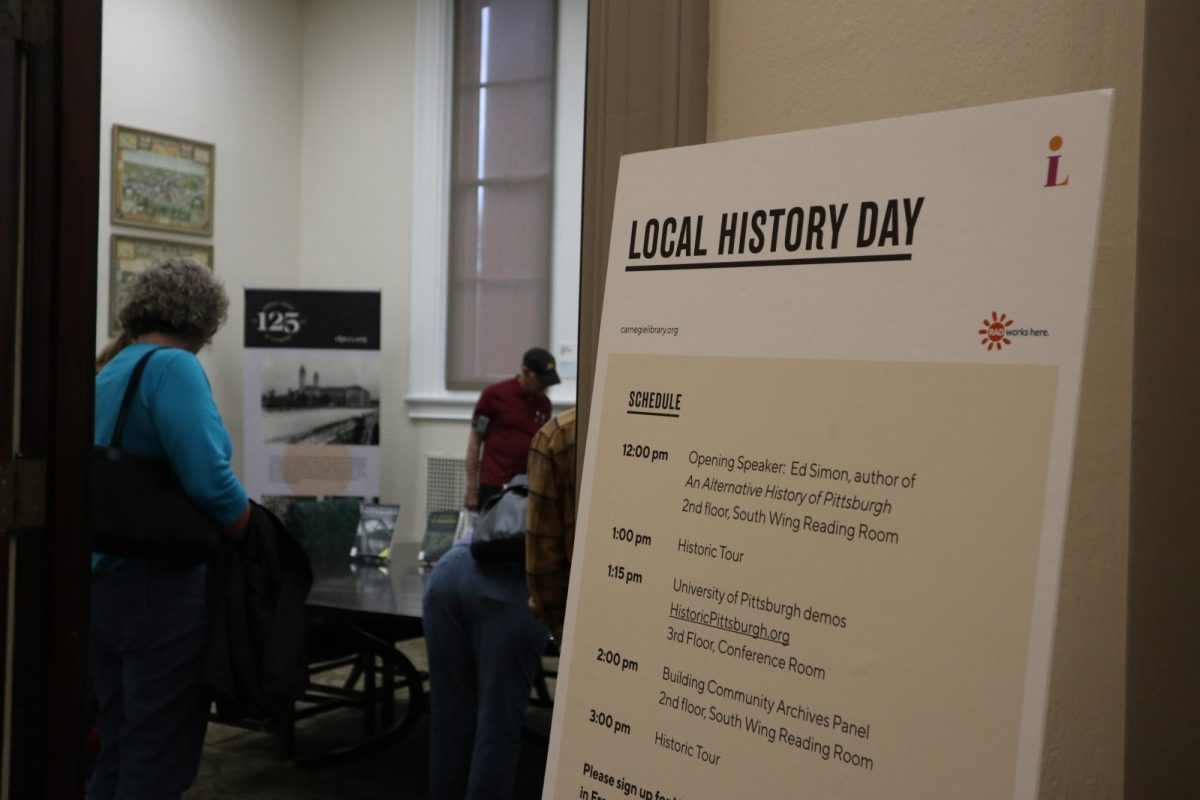The third floor of the Carnegie Library of Pittsburgh in Oakland opened for the first time since late 2021 on Saturday, Nov. 4.
The reopening of the third floor coincided with the library’s Local History Day event, which brought 17 local exhibitors, including the Lawrenceville Historical Society and Rivers of Steel, together to share the city’s history with the public.
Ed Simon, author of “An Alternative History of Pittsburgh,” gave an opening lecture at noon where he talked about little-known aspects of Pittsburgh’s past that are covered in his book, including the city’s legacy as a jazz pioneer.
“Many are not aware that Pittsburgh was one of the most notable cities regarding its contribution to jazz,” Simon said. “Billy Strayhorn grew up in Pittsburgh to become a legendary jazz composer, yet he also lived a tragic life arranging for Duke Ellington.”
Simon also emphasized that Pittsburgh history includes many nationally significant anecdotes. They range from Lawrenceville’s Allegheny Arsenal explosion in 1862 — the deadliest civilian disaster of the Civil War — to the B-52 bomber that crashed into the Monongahela River in 1956 during the Cold War.
“Many local stories in Pittsburgh history were also very much national stories,” Simon said. “For instance, Roberto Clemente transcended news in Pittsburgh with his death in a plane crash on the way to provide relief in Nicaragua.”
Pittsburgh-based archives, museums and historical societies were set up on the library’s second and third floors, and the library prepared book displays of local history titles for the occasion.
Amanda Peters, archivist at the Carnegie Library of Pittsburgh, said that Local History Day is a perfect way to celebrate the public reopening of the library’s Pennsylvania Department, which specializes in local history and genealogy research.
“We hope that visitors see their community represented and realize that many different groups are working to preserve local history,” Peters said.
Presenting at Local History Day was Historic Pittsburgh, the digital collection service hosted by the University of Pittsburgh Library System. Home to more than 35,000 images, Historic Pittsburgh is a fantastic online resource for those wanting to learn more about local history, according to Megan Massanelli, engagement and outreach librarian with the library system’s Archives and Special Collections department.
“Our mission is to preserve the history and culture of Western Pennsylvania and Pittsburgh more generally, but we’re not limited to that,” Massanelli said. “Our collections range from political science to performing arts, and no matter what your interests are, there’s always something in our collections.”
The event also included two historical tours of the Carnegie Library in the afternoon, sharing how the library connects with Pittsburgh’s industrial past. The glass floors of the library’s stacks are made with slag, a byproduct of coal, and the stacks themselves were built with Carnegie steel.
“The fact that Andrew Carnegie was a tremendous philanthropist but also an exploitative industrialist makes him a fascinating character,” Simon said. “Yet there has never been a great novel or movie about Carnegie.”
The Pittsburgh City Archives presented several photographs of the Lower Hill District, which was completely demolished for the Civic Arena sports complex in the 1960s. Giving a rare snapshot into the predominantly African-American Lower Hill before mass demolition, City Archivist Charles Succop said that the photographs will be part of a new website soon to be launched by the City Archives.
“We’ve always had these records, but we are going to be making history more accessible through digitization,” Succop said.
At another table, the Detre Library and Archives at the Heinz History Center shared a few images from their collection. Archivist Sierra Green reinforced that local history gives one a greater passion for their home.
“We see this initiative and passion towards sourcing things locally, like purchasing from local artisans or farmers markets,” Green said. “Why not do that with history?”
Green is currently working on a project to document Pittsburgh’s lost Chinatown, once located downtown between Grant and Ross Streets.
“I’m currently working with two people who grew up in Chinatown, one of whom was the last unofficial mayor of the area,” Green said. “Hearing their memories directly and then seeing how they connect with primary sources is quite inspiring.”
Pittsburgh’s legacy of immigration lives on throughout the city, including at St. Nicolas Church in Millvale, where the 25 Maxo Vanka Murals represent the faith of Croatian immigrants on a grand scale. Vanka was a Croatian-born artist, and the WWII-era murals were recently the recipient of a $471,670 grant to continue an ongoing conservation project.
Pittsburgh history inevitably continues to influence the people and places of the city, according to James Morar, who volunteers with Rivers of Steel to preserve Pittsburgh’s industrial history.
“Many local residents come from families whose ancestors worked long, grueling days in the steel mills, and we can repay that debt left to us by learning about their pasts,” Morar said.



